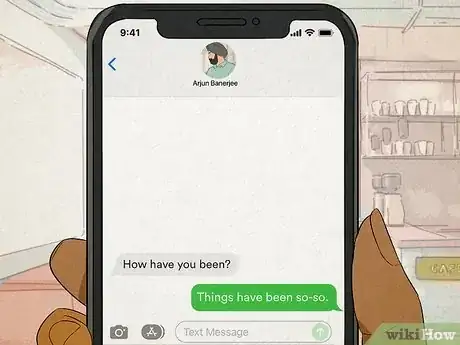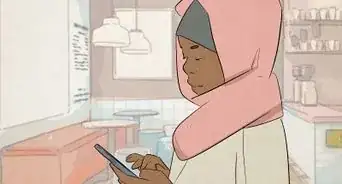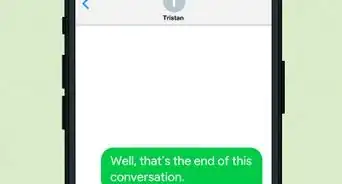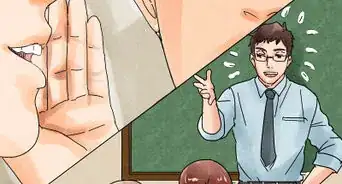This article was co-authored by wikiHow staff writer, Ali Garbacz. Our trained team of editors and researchers validate articles for accuracy and comprehensiveness.
wikiHow’s Content Management Team carefully monitors the work from our editorial staff to ensure that each article meets our high quality standards.
There are 9 references cited in this article, which can be found at the bottom of the page.
This article has been viewed 21,908 times.
Learn more...
You’re meeting up with someone you haven’t seen in a while, and they start off with the question “How have you been?” It’s such a simple question, but what exactly does the other person want to know, and how are you supposed to answer? We’re here to walk you through some examples of responses that will work for lots of different situations and allow you to have a great and meaningful conversation.
Things You Should Know
- Respond with a short, simple answer, such as “Good,” “Great,” or “Not bad” to get the conversation going.
- Offer details about your travels, work, or hobbies to give a longer answer and let the person know what you’ve been up to.
- Ask questions about the other person or things you’re curious about to keep the conversation going.
Steps
Short Responses
-
1“I’ve been good.” This is one of the most standard responses people give when asked how they’ve been. Even when you haven’t been doing all that great, it’s acceptable to use an answer like this. And if you’ve been doing really well, use other adjectives to express that. Some examples are:[4]
- “I’ve been great!”
- “Never better.”
- “Fantastic!”
- “Really, really good.”
-
2“Not bad.” This is a neutral answer. You haven’t been great, but you also haven’t been doing too terribly either. Some other ways to phrase this are:[5]
- “I’ve been doing okay.”
- “Things have been so-so.”
- “I’ve been alright.”
-
3“I’ve been better.” This is a response that lets the other person know that you actually haven’t been doing too great. You’re not obligated to tell them everything’s been great when it hasn’t. Just be prepared for the possibility of having to elaborate a bit more. It’s natural for the other person to show concern and ask follow up questions.[6]
- “Not great, but we’re getting there.”
- “Honestly? Things have been better.”
- “Things have been a bit rough lately.”
Longer Responses
-
1Mention any activities you’ve been doing recently. Pick one or two things that you’ve been doing recently, such as studying, reading, or exercising. When answering, It’s more natural to start off with one of the standard short responses (“Good,” “Not bad,” “Alright,” etc.) and add a longer response after that.[7]
- “Good. I’ve been reading a lot of interesting books lately.”
- “Not bad. I’ve been studying a lot for finals.”
- “Great! I’ve been taking dance lessons at my gym.”
- “I’ve been better. I’ve just been doing lots of work for my job.”
- “Really good. I’ve been meditating every single day.”
-
2Give a short life update. Give them a brief summary of any big or significant events that have happened. This also gives the other person the opportunity to keep the conversation going. They’ll be able to ask follow-up questions and react to your short story.[8]
- “Not bad. I just got back from my trip a few days ago.”
- “Good. My family is coming to visit me tomorrow.”
- “I’ve been better. My classes are really hard this semester.”
- “Pretty good. My internship just ended.”
-
3Talk about something that doesn’t relate to you. Make a comment about something else you find interesting if you don’t have much to say about yourself. You are introducing a new topic and keeping the conversation flowing.[9]
- “Good. The weather’s been so nice lately.”
- “I’ve been pretty good. Everyone’s getting excited for the holidays.”
- “Pretty alright. It’s crazy that it’s already the New Year.”
Keeping the Conversation Going
-
1Ask the other person the same question. After you’ve answered, ask the other person how they’ve been doing. This is common courtesy. It also gives the other person a chance to talk.[10]
- “Good. How’ve you been?”
- “Not bad. How about you?”
- “Pretty good. What about you?”
-
2Answer with a question. This is a great way to include the other person in the conversation. You’re asking for their opinion and giving them the chance to speak.[11]
- “I’ve been good. Did you hear about the new restaurant coming to town?”
- “Pretty good. Hasn’t the weather been crazy lately?”
- “I’ve been doing pretty okay. Did you catch the debate on TV last night?”
- “Not bad. Did you know that they’re thinking about getting rid of the park nearby?”
-
3Steer the conversation towards talking about the other person. Ask the other person a question that relates to them or give them a compliment. By doing this, you’re showing them you’re interested in their life and want to hear what they have to say.[12]
- “I’ve been good. Did you get that job you were applying for?
- “Things have been alright. How was your trip last month?
- “I’ve been pretty good. I saw your post the other day and absolutely loved the pictures you took.”
- “Really good. I love the shirt you’re wearing!”
References
- ↑ https://youtu.be/XWw8mcgDj3A?t=67
- ↑ https://www.phrasemix.com/examples/so-howve-you-been
- ↑ https://youtu.be/XWw8mcgDj3A?t=251
- ↑ https://youtu.be/XWw8mcgDj3A?t=153
- ↑ https://youtu.be/XWw8mcgDj3A?t=153
- ↑ https://www.indeed.com/career-advice/career-development/how-are-you-response
- ↑ https://youtu.be/XWw8mcgDj3A?t=177
- ↑ https://www.phrasemix.com/phrases/how-have-you-been
- ↑ https://www.cnbc.com/2021/08/17/avoid-these-mistakes-if-you-want-to-be-good-at-small-talk-says-public-speaking-expert.html
- ↑ https://dictionaryblog.cambridge.org/2016/08/24/its-been-a-while-starting-a-conversation-with-an-old-friend/
- ↑ https://www.cnbc.com/2021/08/17/avoid-these-mistakes-if-you-want-to-be-good-at-small-talk-says-public-speaking-expert.html
- ↑ https://dictionaryblog.cambridge.org/2016/08/24/its-been-a-while-starting-a-conversation-with-an-old-friend/






































































wikiHow’s Content Management Team carefully monitors the work from our editorial staff to ensure that each article meets our high quality standards. This article has been viewed 21,908 times.